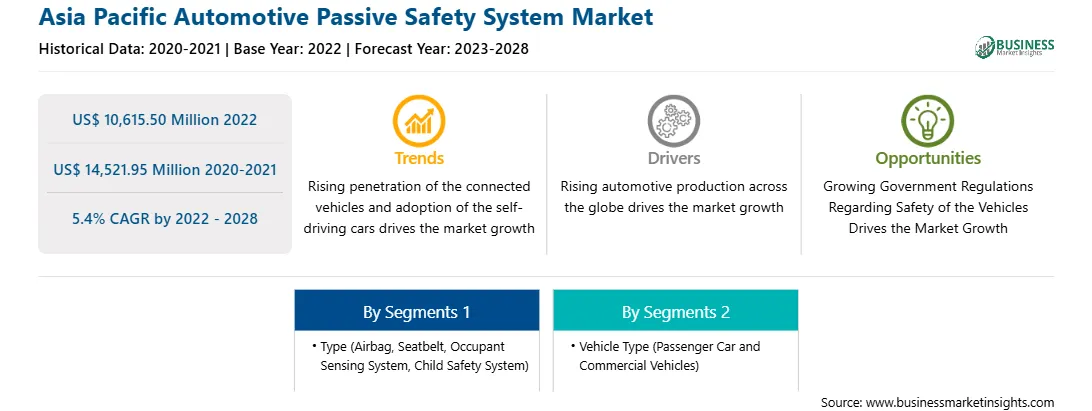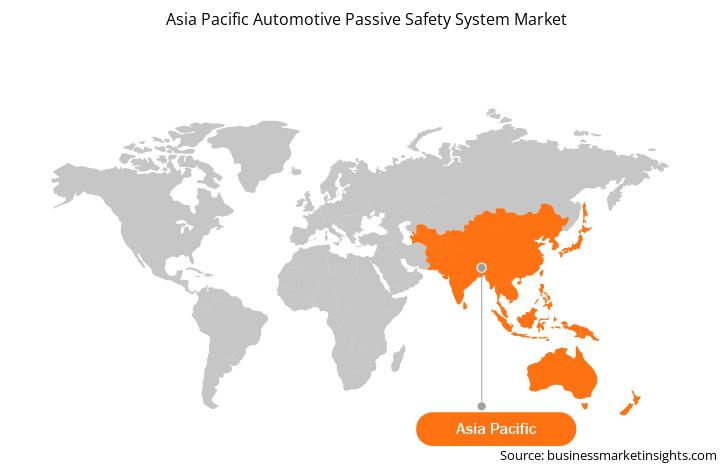The automotive passive safety system market in Asia Pacific is expected to grow from US$ 10,615.50 million in 2022 to US$ 14,521.95 million by 2028. It is estimated to grow at a CAGR of 5.4% from 2022 to 2028.
Rising Automobile Production
Urbanization trends, increasing average disposable income of urban dwellers that has enabled people to improve their lifestyles has further accelerated the demand for passenger cars. As a result, automakers across the region are ramping up production to meet customer demand. Vehicle production, specifically passenger cars and commercial vehicles, has increased steadily in both developed and developing countries in recent years. More vehicle production means more requirement of passive safety system units mainly seatbelts and airbags to enhance occupant security. This is acting as a major growth driver for the automotive passive safety systems market. Falling loan interest rates are also fueling growth in the auto industry, which is supporting the passive safety system sales. In 2021, China, India, Japan, and South Korea produced many automotive vehicles, including passenger and commercial vehicles. The rise in automobile production, along with rising concerns for occupant safety and security has created a need for automotive passive safety structures. Thus, increase in automobile production is driving the market sales for airbags, seatbelts, occupant safety systems, and other passive safety systems that improve the safety and driving experience.
Market Overview
China, India, South Korea, Japan, and Australia are among the key economies in APAC. These economies are performing well, owing to the numerous technological and infrastructural developments. The region has a robust automotive sector, which is supported by the expansion in the automotive manufacturing industry in countries such as China, India, and South Korea. Countries, such as India, China, South Korea, and Japan are among the leading vehicle manufacturing countries worldwide. For instance, According to the Society of Indian Automobile Manufacturers (SIAM), India produced 22,933,230 vehicles, of which 3,650,698 were passenger vehicles and 805,527 were commercial vehicles in 2021. In 2021, China emerged as the largest vehicle-producing country in the world. According to the China Association of Automobile Manufacturers (CAAM), the overall production and sales of passenger vehicles in china amounted to 21.408 million units and 21.482 million units, respectively. The Japanese automobile sector is still thriving, with Japanese manufacturers making and selling many vehicles worldwide. Due to increased automotive production in Japan, Japan's automotive component manufacturing industry is predicted to be among the most opportunistic third to only the US and Germany. The automotive component industry in Japan has expanded in tandem with the increase in the number of automobile manufacturers in the country, owing to the increasing number of passenger and commercial vehicles on the road. The presence of a strong automotive sector and the increasing number of car manufacturers are the major factors driving the growth of the automotive passive safety system market in the region.
Asia Pacific Automotive Passive Safety System Market Revenue and Forecast to 2028 (US$ Million)
Strategic insights for the Asia Pacific Automotive Passive Safety System provides data-driven analysis of the industry landscape, including current trends, key players, and regional nuances. These insights offer actionable recommendations, enabling readers to differentiate themselves from competitors by identifying untapped segments or developing unique value propositions. Leveraging data analytics, these insights help industry players anticipate the market shifts, whether investors, manufacturers, or other stakeholders. A future-oriented perspective is essential, helping stakeholders anticipate market shifts and position themselves for long-term success in this dynamic region. Ultimately, effective strategic insights empower readers to make informed decisions that drive profitability and achieve their business objectives within the market. The geographic scope of the Asia Pacific Automotive Passive Safety System refers to the specific areas in which a business operates and competes. Understanding local distinctions, such as diverse consumer preferences (e.g., demand for specific plug types or battery backup durations), varying economic conditions, and regulatory environments, is crucial for tailoring strategies to specific markets. Businesses can expand their reach by identifying underserved areas or adapting their offerings to meet local demands. A clear market focus allows for more effective resource allocation, targeted marketing campaigns, and better positioning against local competitors, ultimately driving growth in those targeted areas.Asia Pacific Automotive Passive Safety System Strategic Insights

Asia Pacific Automotive Passive Safety System Report Scope
Report Attribute
Details
Market size in 2022
US$ 10,615.50 Million
Market Size by 2028
US$ 14,521.95 Million
CAGR (2022 - 2028) 5.4%
Historical Data
2020-2021
Forecast period
2023-2028
Segments Covered
By Type
By Vehicle Type
Regions and Countries Covered
Asia-Pacific
Market leaders and key company profiles
Asia Pacific Automotive Passive Safety System Regional Insights

Asia Pacific Automotive Passive Safety System Market Segmentation
The Asia Pacific automotive passive safety system market is segmented into type, vehicle type and country.
Autoliv Inc; Continental AG; FAURECIA; Hyundai Mobis; Joyson Safety Systems; Knauf Industries; Robert Bosch GmbH; Tokairika Co., Ltd.; Toyoda Gosei Co., Ltd; and ZF Friedrichshafen AG are the leading companies operating in the Asia Pacific automotive passive safety system market.
The Asia Pacific Automotive Passive Safety System Market is valued at US$ 10,615.50 Million in 2022, it is projected to reach US$ 14,521.95 Million by 2028.
As per our report Asia Pacific Automotive Passive Safety System Market, the market size is valued at US$ 10,615.50 Million in 2022, projecting it to reach US$ 14,521.95 Million by 2028. This translates to a CAGR of approximately 5.4% during the forecast period.
The Asia Pacific Automotive Passive Safety System Market report typically cover these key segments-
The historic period, base year, and forecast period can vary slightly depending on the specific market research report. However, for the Asia Pacific Automotive Passive Safety System Market report:
The Asia Pacific Automotive Passive Safety System Market is populated by several key players, each contributing to its growth and innovation. Some of the major players include:
The Asia Pacific Automotive Passive Safety System Market report is valuable for diverse stakeholders, including:
Essentially, anyone involved in or considering involvement in the Asia Pacific Automotive Passive Safety System Market value chain can benefit from the information contained in a comprehensive market report.